Pineapple Chunk Cannabis Strain Week-by-Week Guide
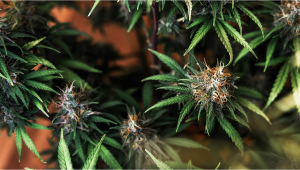
- 1. Grow specifications
- 2. Grow set up
- 3. Germination and seedling stage | week 1
- 4. Early veg | weeks 2-4
- 5. Mid and late veg | weeks 5-9
- 6. Transition (pre-flower) | weeks 10-11
- 7. Early flower | weeks 12-13
- 8. Mid flower (bulk phase) | weeks 14-16
- 9. Ripening and harvest | week 17-18
- 10. Yield and smoke report
- 11. In conclusion
Pineapple Chunk is among the all-time favorite strains in the collection of Barney’s Farm cannabis seeds bank. The strain’s name fully reflects what this weed is all about – it produces chunky and heavy colas with an incredible smell: it’s pungent and cheesy with a distinct fruity sweetness. The taste of the smoke is deliciously earthy and leaves an aftertaste of ripe pineapple. The effect of this dominant Indica is a strong body buzz with cerebral stimulation and gentle euphoria.
Pineapple Chunk is also an exceptional cultivar as you can see for yourself in this week-by-week growing guide. She might be a bit slow out of the gate but once she picks up pace, she is unstoppable, tolerating any kind of abuse and bringing in an ample harvest of premium bud.
1. Grow Specifications
Pineapple Chunk is 80% Indica, so she doesn’t grow very tall and reaches a comfortable 90-100 cm (about 3ft) both indoors and outdoors. With proper training, you can turn her into a bushy plant with multiple fat colas, and, regardless of the structure, she will yield as much as 600 gr/m2 (2 oz/ft²). You can expect an equally generous harvest outdoors although the breeder didn’t specify exact figures.
The perfect harvest window comes within 55-60 days from the moment you switch to 12/12, and outdoor growing will finish by mid-September (in warm temperate climates). The buds are top-grade as they have around 20% THC in well-grown samples and a rich terpene profile with a dominating flavor of earth enhanced by notes of skunky cheese and sweet pineapple. The level of CBD is not as high as in modern CBD-rich varieties but also not low as far as old-school recreational weed goes – around 1% of dry weight.

The combination of a moderate THC content and plenty of lively terpenes means that Pineapple Chunk provides an energizing and motivating high. You can use these buds at practically any time of day, as they won’t overstimulate you before bed. However, this strain really comes into its own when put to use early in the morning alongside a fresh and strong cup of coffee. You’ll feel your motivation levels soar after the first hit. By the time you reach the end of the joint, you’ll be ready to take on the day! For the more adventurous, this strain also makes an excellent addition to brownies and other edibles. The high hits much more intently, and you’ll get to experience all of the flavors that the terpene profile has to offer.
2. Grow Set Up
In this run, the grower planted 4 different strains, including Pineapple Chunk, in one 4x4 grow tent by CoolGrows. The guy rated it highly for its sturdy zippers and thick material. This spacious tent was equipped with a HLG 550W LED light with red diodes. With about 31 watts per square foot at full power, this was quite enough for both the vegetative phase and different stages of flowering. There was also a need for a humidifier because RH was very low throughout the grow.
| Grow Space: | 1.49 m2 (16 ft2) | Pot Size: | 18.93 l (5 gal) |
|---|---|---|---|
| Seed to Harvest: | 18 weeks | Medium: | Soil |
| Flowering: | 9 weeks | Nutrients: | Synthetic/Organic |
| Light Cycle: | 18/6 → 12/12 | pH Levels: | 6.4-6.8 |
| Light Type: | LED | Day Temperature: | 26-31°C (78-88°F) |
| Watts Used: | 500 | Humidity: | 18-38% |
3. Germination And Seedling Stage | Week 1
Germinating cannabis seeds and taking care of a young seedling isn’t hard science. Nevertheless, you should take into account a few things to increase your success rate. First, the temperature must be comfortably warm – around 26-28°C and the relative humidity better be rather high (70-80%). And if the air is too dry (like it was in this grow), use a humidity dome to cover your seedling and raise RH locally. Also, before seeds pop from the ground, turning on the light or not is up to you.
| Plant Height: | 3“ (7.6 cm) | Humidity: | 22% |
|---|---|---|---|
| Distance to Light: | 48“ (122 cm) | Water per Day: | 0.1 gal (0.38 l) |
| Day Temp: | 88°F (31°C) | pH: | 6.8 |
| Night Temp: | 78°F (26°C) | TDS: | 300 ppm |
Since Pineapple Chunk is a photoperiod variety, it’s okay to transplant her as many times as you see fit – each time increasing the size of the pot. So, this grower planted his seeds in small starter containers while bigger 5-gallon smart pots were standing by.
Although constantly repotting photoperiod strains can help to prevent over-watering and under-watering, it does come with several risks. You need to make sure that you keep up with your plant as it grows. If you leave your specimen in a smaller pot for too long it can become root bound. This occurs when the roots reach the side of the pot and begin to spiral together. Even after transplanting, a tight root ball can struggle to take up nutrients and water as successfully compared to a healthy and expansive root system. You can help your plant along by gently breaking up the bottom of the root system before transplanting it over to a new pot.
He was using 100% Batch 64 Moonshine soil which is a coco-based mix, pre-amended with some organic nutrients to last up to 4 first weeks. Other, more common soil mixes are usually also loaded with enough nutes to get you through the seedling stage and early vegetative phase. Meaning you can only use water without any fertilizers if you want.
Once your seedling is up, the light must be on, and make sure it’s not too close and not running at full power. Otherwise, you can stunt your little plant with too much light and cause light stress. It’s better to let her stretch a bit but not too much. Some tweaking and tuning over the first couple of days are necessary.
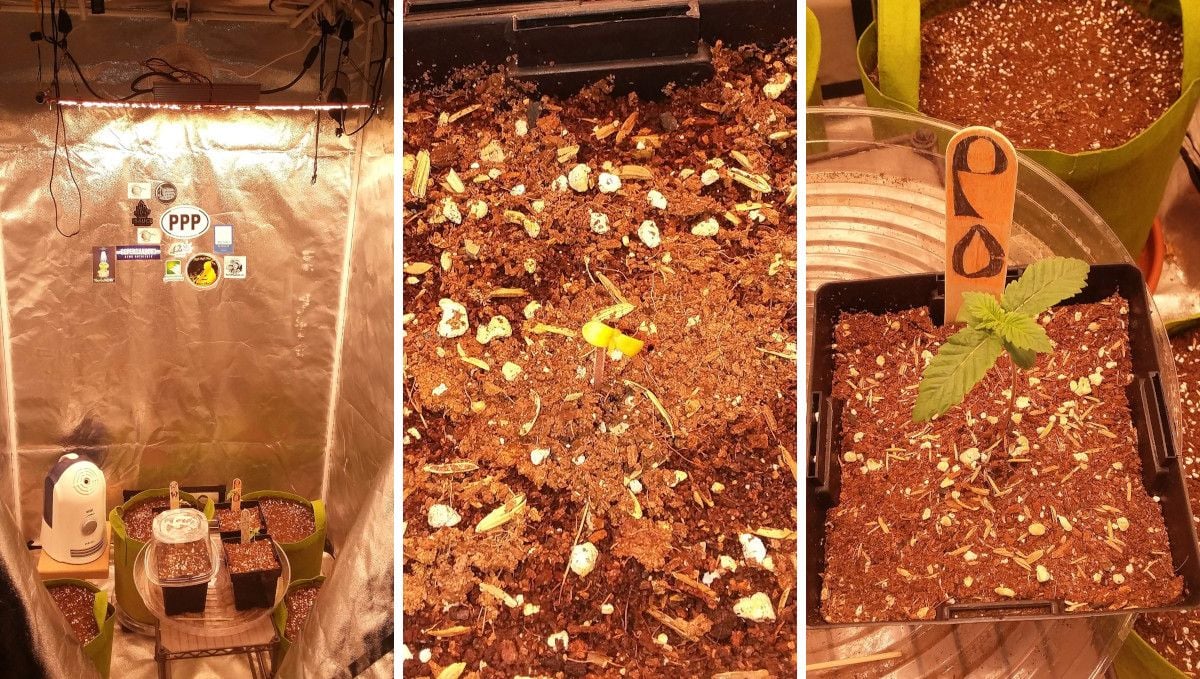
4. Early Veg | Weeks 2-4
When we were selecting a Pineapple Chunk week-by-week grow report, we came across several grow journals whose authors complained of the slow progress of their ladies in early veg. However, once the plants were established, they picked up the pace and finished strong. In this run, the seedling was also kind of slow but only in the beginning.
| Plant Height: | 5-9“ (12.7-23 cm) | Humidity: | 22% ↗ 34% ↘ 18% |
|---|---|---|---|
| Distance to Light: | 48“ (122 cm) | Water per Day: | 0.1 gal (0.38 l) |
| Day Temp: | 88°↘86°F (31°↘30°C) | pH: | 6.8 ↘ 6.4 |
| Night Temp: | 78°↘74°F (26°↘23°C) | TDS: | 300 ppm |
In week 2, Pineapple Chunk needed support – otherwise, she would topple over because of the weight of leaves on the top. Otherwise, she looked fine, and the grower gave her the first feeding – only ¼ of what is recommended, for starters. We suggest you do the same – this way there’s less risk of nutrient burn. Also, young cannabis doesn’t need nutrients every time you water her. You can alternate feedings with just plain water.
The lack of structural integrity came about due to a lack of light intensity following germination. We recommend that you switch your lights on for 24 hours per day as soon as the shoot emerges from the soil. This will stop overproduction of growth hormones from forcing your plant to stretch due to a desperate search for photons in the early stages. Of course, you can support your plant growing forward, but it’ll be a task of tipping over and snapping for the rest of the growing cycle—especially outside where it will be subject to strong winds and other adverse weather events.
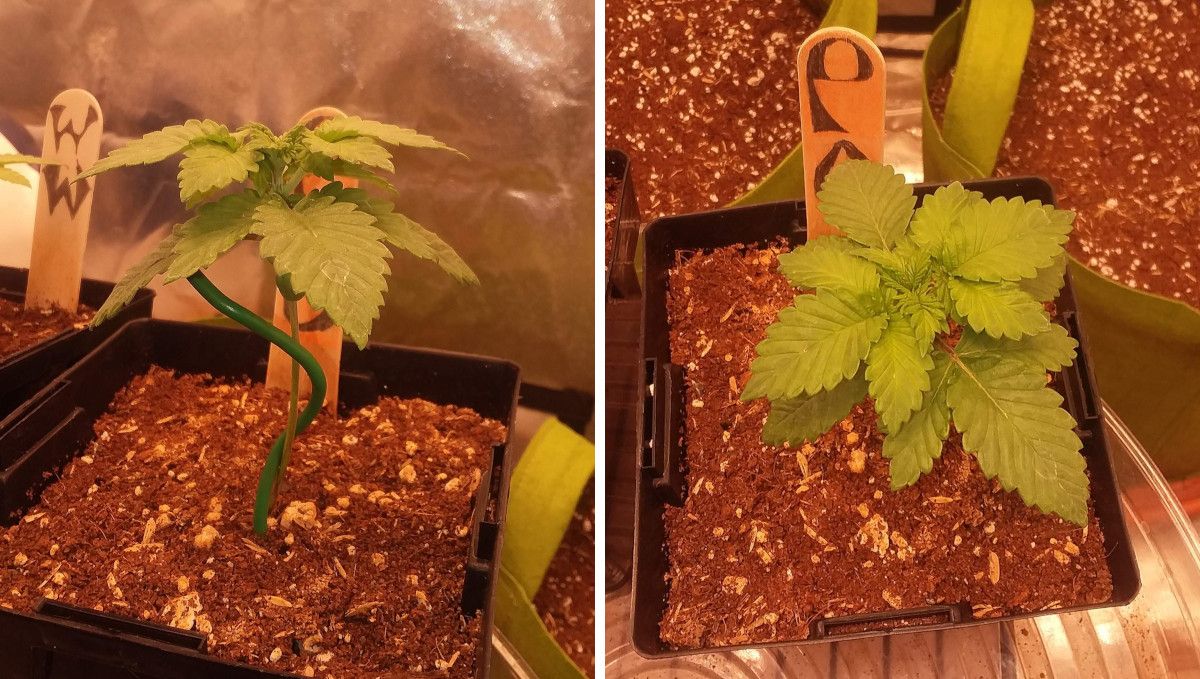
In the third week, the gardener was out of town and left his garden to a caretaker. When he came back, he found the plants overwatered – a classic rookie mistake. Overwatering starts with clawing leaves, but if the problem persists, the leaves begin to yellow and die off, starting from the bottom. If you notice this, let the medium dry out for a few days until the pot feels light and the leaves start to droop listlessly – it means the plants are thirsty again.
When Pineapple Chunk and others recovered, the gardener repotted them. It’s easy to tell when to repot: when the leaves reach the edges of the starter container or overgrow them or when you see roots appear in drainage holes.
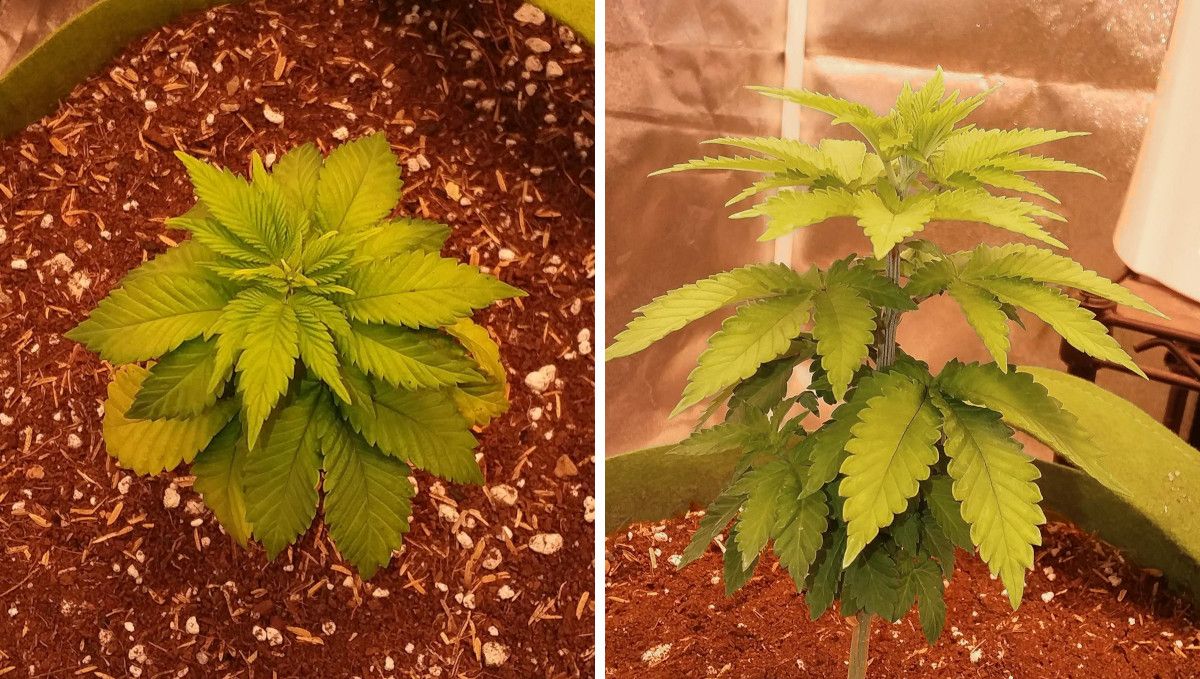
5. Mid And Late Veg | Weeks 5-9
By the end of the first month, most autoflowers would enter the flowering stage, but with photoperiod varieties, you can extend veg indefinitely – as long as you don’t switch to 12/12. You can use this extra time to grow a bigger plant or to train her exactly the way you want.
| Plant Height: | 9-20“ (23-51 cm) | Humidity: | 18-28% |
|---|---|---|---|
| Distance to Light: | 48“ (122 cm) | Water per Day: | 0.07-0.25 gal (0.38-1 l) |
| Day Temp: | 86°F (30°C) | pH: | 6.4-6.5 |
| Night Temp: | 74°F (23°C) | TDS: | 300-900 ppm |
Throughout weeks 5 and 6, the gardener heavily trained his Pineapple Chunk. He started with defoliation – when he removed all fan leaves except the two on top – then let the girl recover and topped her. All this was meant to stop the central stem from growing and stimulate the side growth.
When the side branches were long enough, the grower proceeded to tie them horizontally in a compass pattern. He also removed the lowest two branches which are usually too weak anyway. And he kept pruning all growing points along the branches, leaving only those on top. It’s a variation of the mainlining technique and is meant to create several colas of roughly the same size and texture.
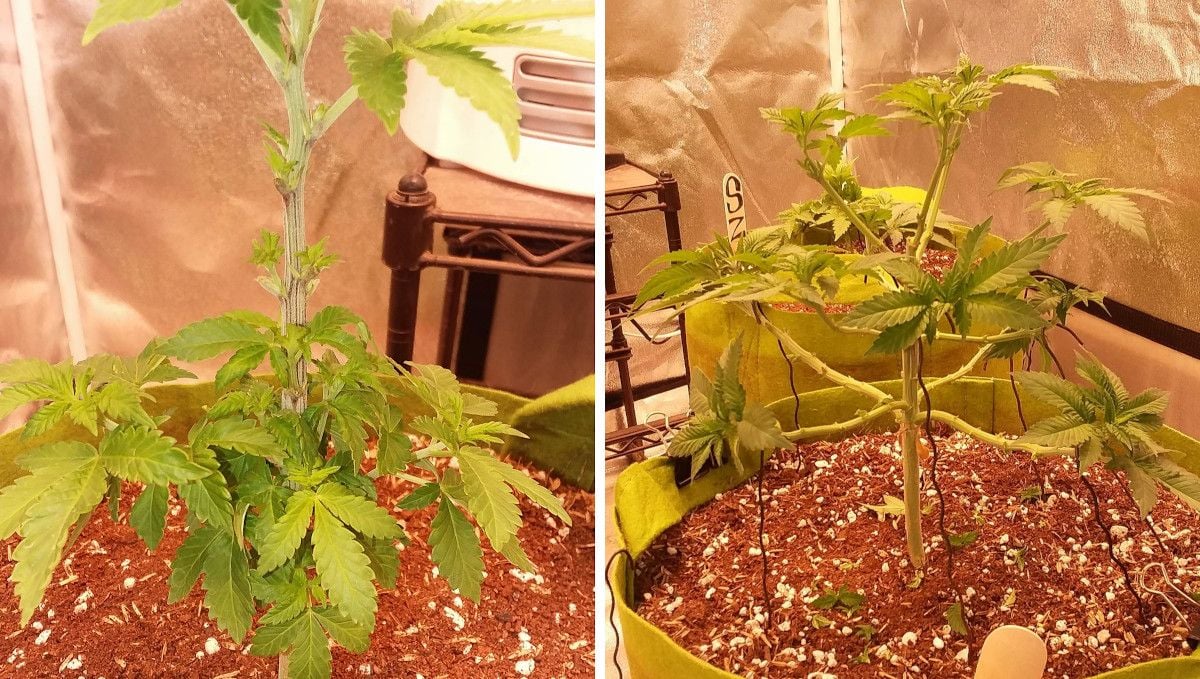
It’s debatable whether so much high-stress training leads to better results. On the one hand, you get an even canopy, with most bud sites at the same distance from the light and very uniform-looking nuggets at harvest. On the other, overtraining makes the vegetative phase so much longer.
The same goes for defoliation. No matter how many leaves you remove (in veg), the plant seems to grow twice as many. As if she tells you, “Leave me alone, I really need those leaves”.

Anyway, the gardener had a vision of what his Pineapple Chunk should look like and he followed the plan, paying no attention to how much time it took. He fertigated his plants every 6 days and expected they’d grow root systems big enough to need food and water every 3-4 days.
He was still using veg nutrients (heavy on nitrogen) and planned to continue with them even in the first week of 12/12 – to give his cannabis enough N for the flowering stretch. And here’s what he was using (all products by Remo Nutrients):

6. Transition (Pre-Flower) | Weeks 10-11
When you change your light schedule from whatever it was to 12 hours of light and 12 hours of darkness, the budding doesn’t begin right away. Usually, plants need about a week of 12/12 to transition. In the case of landrace Sativas, even two weeks or more.
But if it’s been longer and nothing happens, check whether you expose your garden to light during the dark period. Even if the light leak is very weak or you turn on a bulb even for a few seconds, it will disrupt the flowering. With autoflowers, you won’t have any such problems.
| Plant Height: | 20-28“ (51-71 cm) | Humidity: | 28-38% |
|---|---|---|---|
| Distance to Light: | 48“ (122 cm) | Water per Day: | 0.33 gal (1.25 l) |
| Day Temp: | 86↘78°F (30↘26°C) | pH: | 6.5 |
| Night Temp: | 74°F (23°C) | TDS: | 900 ppm |
During the transition to flowering, Pineapple Chunk grew a huge amount of foliage because the grower didn’t want to induce any stress by defoliation at this crucial point in the life cycle. She also had a lot of branches. Three of them were the most developed, the other somewhat smaller in size.
Note: If you do a classic ‘textbook’ mainlining, ALL branches will be the exact same size because they all originate from one pair at the same node (usually the 2nd).
In addition to the signs of the pre-flowering stage, such as alternating nodes and first hairs at the nodes, Pineapple Chunk started to grow pistils on tops. She began to stretch but not much, and the guy proceeded to pluck the larger fan leaves that were shading the lower growth. He was removing maybe 10 leaves a day, but the girl still looked incredibly lush. Usually, when an Indica starts with broad leaves, they get more narrow as she grows, but not with this Pineapple Chunk.

In the second week of 12/12, the budding was already going full steam, and the grower switched to the flowering nutrients as shown:

7. Early Flower | Weeks 12-13
In the early flower, be prepared to see a lot of stretching which may come as a surprise for first-time growers. They assume that cannabis stops vertical growth when the grow stages are over, but nothing is farther from the truth. After the 12/12 flip, the plants can double in size easily. Too many grow cycles have ended in disaster because the grower induced the flowering too late – when the plant was already too big.
| Plant Height: | 32-35“ (81-89 cm) | Humidity: | 38% |
|---|---|---|---|
| Distance to Light: | 48“ (122 cm) | Water per Day: | 0.33 gal (1.25 l) |
| Day Temp: | 78°F (26°C) | pH: | 6.5 |
| Night Temp: | 74°F (23°C) | TDS: | 900 ppm |
For this Pineapple Express, the stretch stopped at about 4 weeks into flowering when she reached the height of 35 inches (89 cm). For an indoor plant, it’s tall enough to seriously shade the bud sites in the lower third, and so they better be removed. Otherwise, a lot of energy will be spent on weightless popcorn buds with zero bag appeal. This technique is called lollipopping. Besides that, the guy kept removing the largest shade leaves to increase the light penetration.
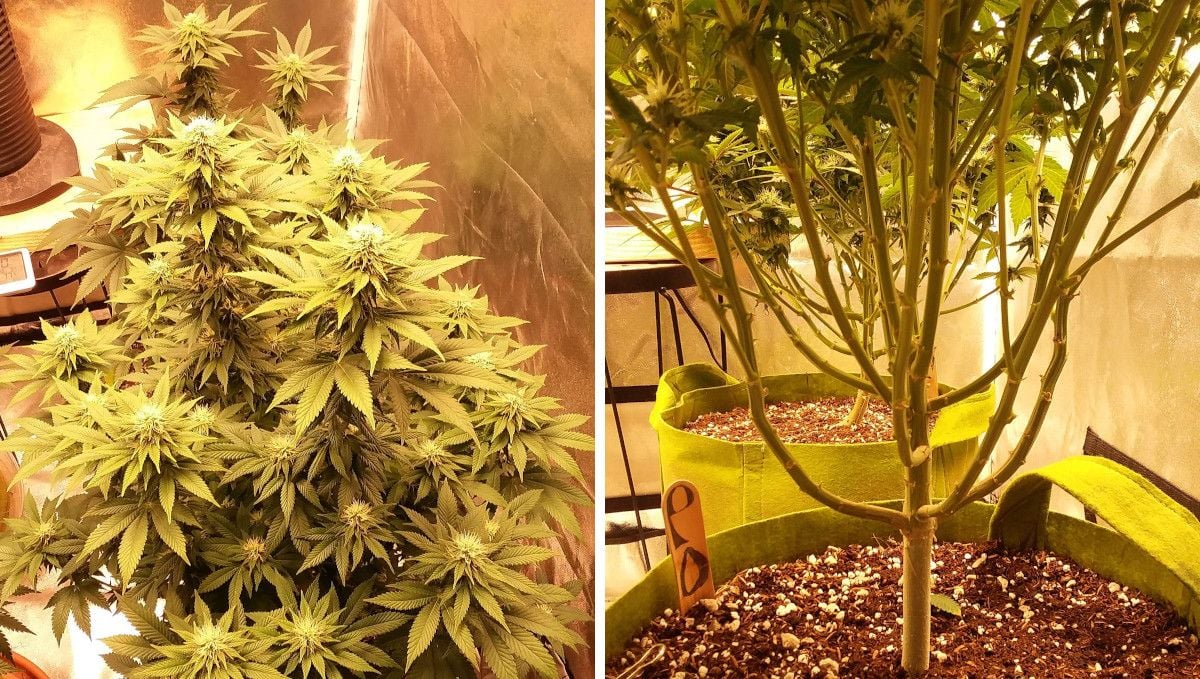
As you can see in the pic above, Pineapple Chunk looked gorgeous and healthy. When everything is alright, flowering time is the most uneventful period. You finally leave your ladies alone – no more training and no defoliation – and keep fertigating (which by now should become a routine for you). The only decision the gardener made was to start tapering the Cal-Mag supplement. He thought that at this point in the timeline, his girl didn’t need much of either. Although we should mention that in coco, calcium and magnesium deficits are very common, so watch out!
8. Mid Flower (Bulk Phase) | Weeks 14-16
When the buds begin to bulk up, they become vulnerable to mold and bud rot. The risk of both increases when there’s insufficient ventilation in the grow room or the foliage is too dense for free air movement. The other culprit is a too big difference between day and night temps – more than 10 degrees – because it leads to dew when lights are turned off. But, of course, the main risk is the too high relative humidity.
In this run, the RH was uncomfortably low in earlier stages but it was just right for the flowering phase.
| Plant Height: | 35“ (89 cm) | Humidity: | 38% |
|---|---|---|---|
| Distance to Light: | 48“ (122 cm) | Water per Day: | 0.33 gal (1.25 l) |
| Day Temp: | 78°F (26°C) | pH: | 6.5 |
| Night Temp: | 74°F (23°C) | TDS: | 900 ppm |
At this point in the timeline, cannabis is still very hungry. Most growers give it as much food as before or even increase the dosages. Later, they offset this by abundantly flushing the medium with lots of plain water or even some special flushing formulas for a week or two. However, this particular gardener decided to taper first MaginifiCal and then all the rest of the products and then just give his Pineapple Chunk usual amounts of plain water for the last two weeks. Well, as a way to flush cannabis, this works too.
Otherwise, not much happens at this time. Buds continue to fatten and stack up as they fill the gaps between nodes. The pistils, which start as greenish-white, begin to turn orange as they fade and dry out. This is one of the signs telling you that the harvest is near and that you should start watching trichomes under a jeweler’s loupe.
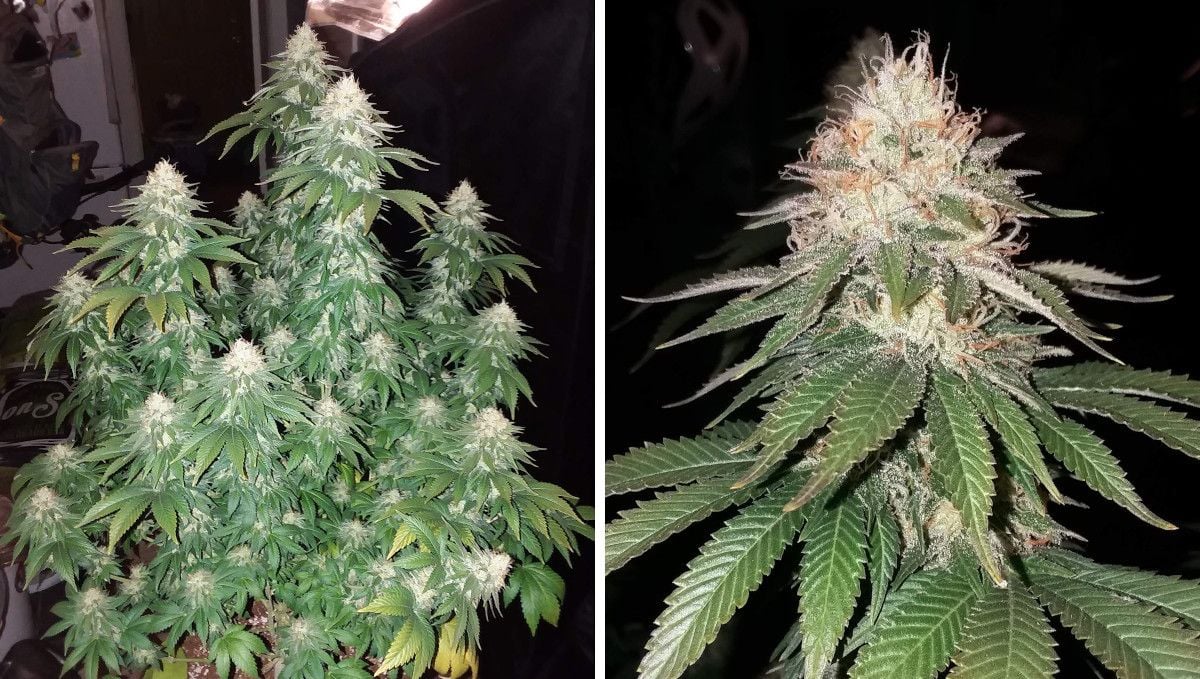
9. Ripening And Harvest | Week 17-18
The last week or two in the life cycle of a cannabis plant is all about getting rid of a salt built-up in the medium and plant tissues as well as not missing the perfect window for harvest.
| Plant Height: | 35“ (89 cm) | Humidity: | 38% |
|---|---|---|---|
| Distance to Light: | 48“ (122 cm) | Water per Day: | 0.33 gal (1.25 l) |
| Day Temp: | 78°F (26°C) | pH: | 6.8 |
| Night Temp: | 74°F (23°C) | TDS: | 300 ppm |
In the 8th week of flowering, the grower started to monitor trichomes through a hand microscope. The trick is not to miss the right moment so that the buds are flushed of any unwanted chemicals by the moment they rich the peak of their quality. Usually, when most of the trichomes are cloudy and a few are still clear, you should start the final flush.
When growing in soil, one needs to flush for two weeks to get the cleanest buds possible. In coco/hydro setups, one week of flushing is enough, so maybe you can start it a bit later – when all trichomes have turned cloudy and there are a few amber ones. The amber color means that THC in the resinous glands has started to degrade and turn into CBN (which makes the effect more sedating).
Another thing that happens around this time is the fade. It was especially pronounced in this grow since the gardener have stopped giving his Pineapple Chunk calcium and magnesium rather early. Magnesium deficiency makes fan leaves go yellow, starting from the lowest ones, and calcium deficiency makes the leaves spotty and twisted. You can see both in the pic below.
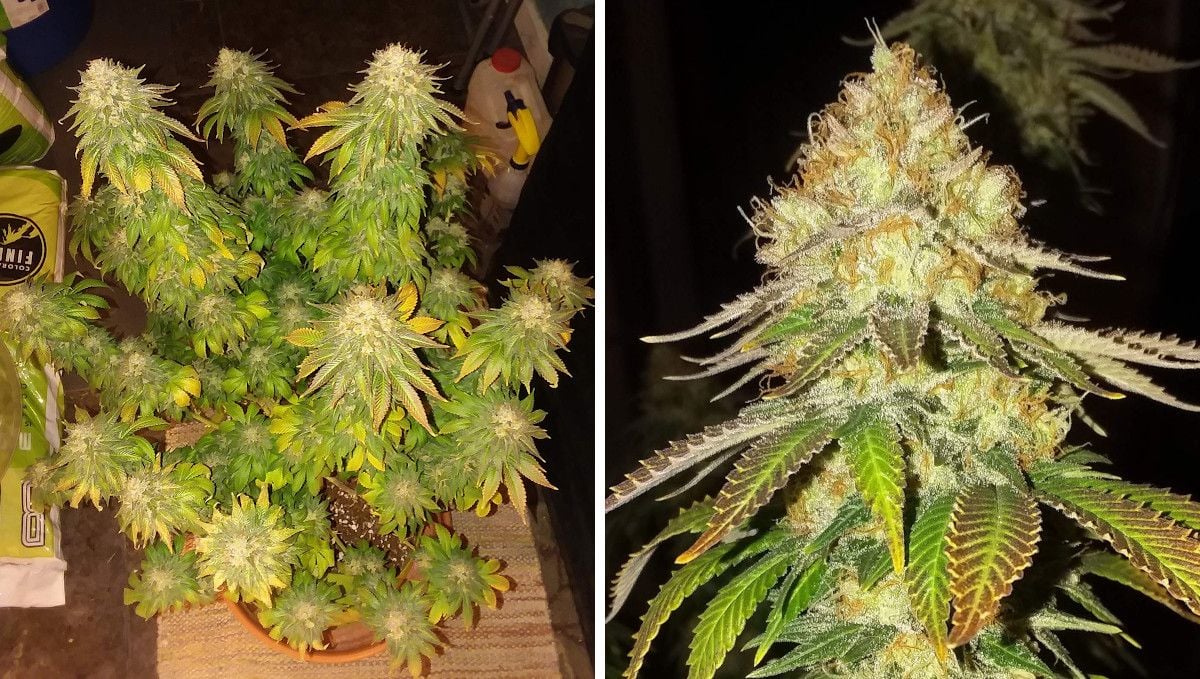
If you still have a lot of fan leaves and want to make it easier for yourself to trim the plant after harvest, you can do the so-called pre-harvest defoliation. Removing some of the leaves won’t hurt anything now. This is what this gardener did and he also skipped the last scheduled watering, gave his Pineapple Chunk another two days to drink the last drops from the medium, and then chopped her in the 9th week of flowering.
10. Yield and Smoke Report
The grower wasn’t completely satisfied with his Pineapple Chunk yield. Nevertheless, he managed to harvest 133 g (4.69 oz) of dry bud of premium quality. We’d say it’s a very good result although not quite proportionate to the length of the grow cycle. The gardener has probably wasted time high-stress training this plant and extending the veg week after week. He could have achieved the same outcome with shorter veg and less stressful methods.
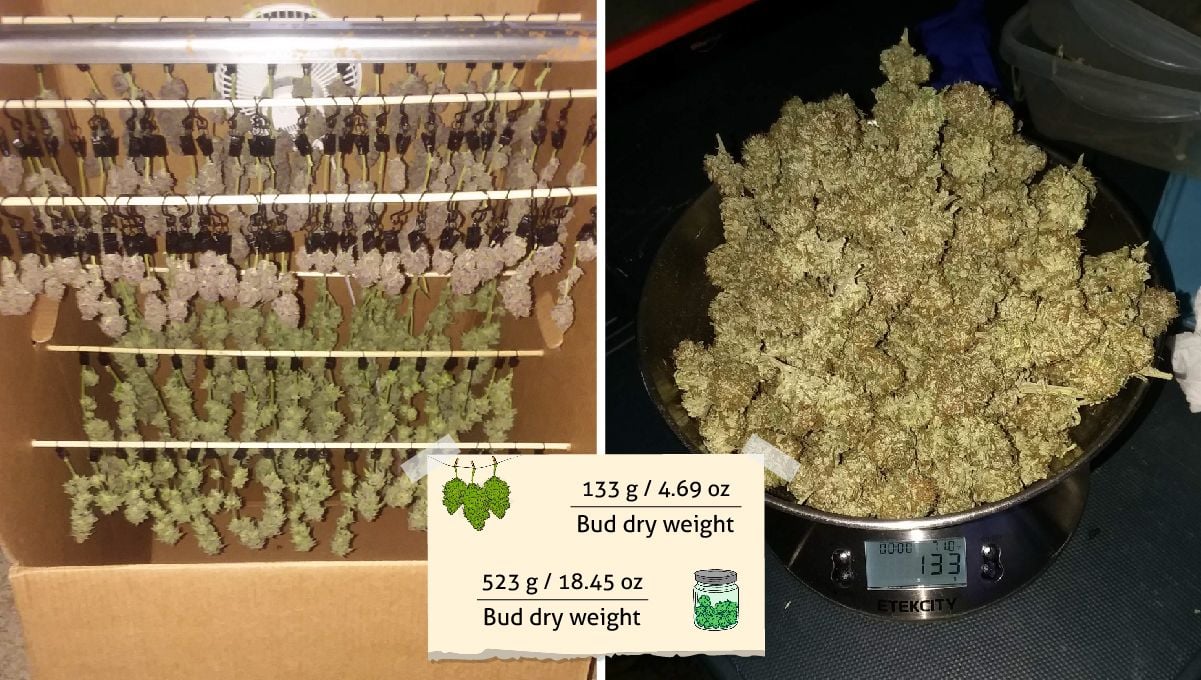
The guy described the smoke as sweet and flowery with citrus notes and the high as having 100% Sativa qualities. It made him happy and relaxed and increased his appetite.
I've smoked a little bit of this already. I like it in the morning with my espresso.
Quexos
11. In Conclusion
Based on this and other grows we have reviewed, Pineapple Chunk is a robust, healthy, and potentially highly productive indoor plant that doesn’t stretch too much and finishes flowering quite fast. She has sturdy enough branches to support heavy buds in late flower and can also handle intense lighting.
The calyx-to-leaf ratio on this particular pheno wasn’t very good and the buds required some serious trimming, even after pre-harvest defoliation. When trimmed, the bag appeal of the buds was top-notch, though, as they were dense and resinous and smelled pleasant and strong. All in all, Pineapple Chunk is a first-rate photoperiod strain, totally worth your attention. Happy growing!
External References
- Optimizing Photoperiod Switch to Maximize Floral Biomass and Cannabinoid Yield in Cannabis sativa L.: A Meta-Analytic Quantile Regression Approach, Frontiers in Plant Science, 10 January 2022
- An Update on Plant Photobiology and Implications for Cannabis Production, Frontiers in Plant Science, 29 March 2019








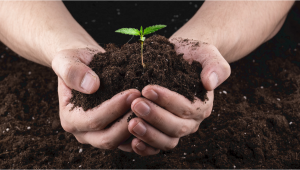
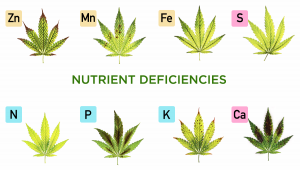

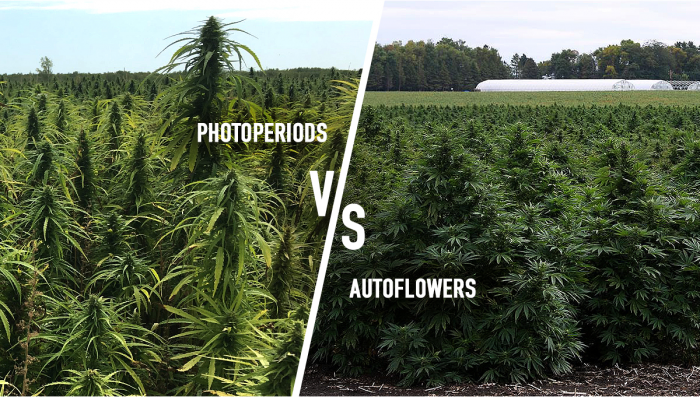

Comments